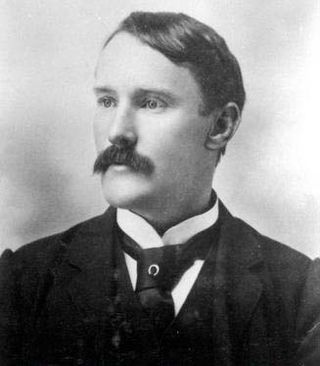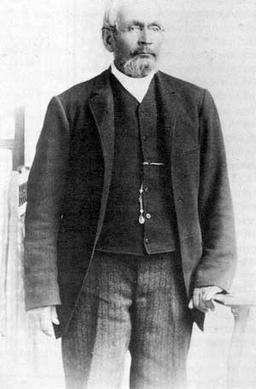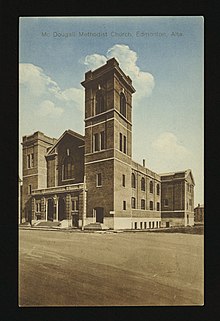James Woodsworth (1843–1917) was a late-19th-century Superintendent of Methodist Missions in the North-West of Canada, which then included all four of today's western provinces. He fathered James Shaver Woodsworth, who was the first leader of the Co-operative Commonwealth Federation.
Fort Edmonton was the name of a series of trading posts of the Hudson's Bay Company (HBC) from 1795 to 1914, all of which were located on the north banks of the North Saskatchewan River in what is now central Alberta, Canada. It was one of the last points on the Carlton Trail, the main overland route for Metis freighters between the Red River Colony and the points west and was an important stop on the York Factory Express route between London, via Hudson Bay, and Fort Vancouver in the Columbia District. It also was a connection to the Great Northland, as it was situated relatively close to the Athabasca River whose waters flow into the Mackenzie River and the Arctic Ocean. Located on the farthest north of the major rivers flowing to the Hudson Bay and the HBC's shipping posts there, Edmonton was for a time the southernmost of the HBC's forts.

The Presbyterian Church in Canada is a Presbyterian denomination, serving in Canada under this name since 1875. The United Church of Canada claimed the right to the name from 1925 to 1939. According to the Canada 2001 Census 409,830 Canadians identify themselves as Presbyterian, that is, 1.4 percent of the population.
Fort Edmonton Park is an attraction in Edmonton, Alberta, Canada. Named for the first enduring European post in the area of modern-day Edmonton, the park is the largest living history museum in Canada by area. It includes both original and rebuilt historical structures representing the history of Edmonton, and is staffed during the summer by costumed historical interpreters.

Fort Victoria, near present-day Smoky Lake, Alberta, was established by the Hudson's Bay Company in 1864 on the North Saskatchewan River as a trading post with the local Cree First Nations. It had previously been settled in 1862 as a Methodist Missionary site, on the location of an aboriginal meeting place. It was named Victoria Settlement, after Queen Victoria.
Ralph Garvin Steinhauer, was the tenth lieutenant governor of Alberta, and the first Aboriginal person to hold that post.

Robert Terrill Rundle was a Cornish Wesleyan Methodist missionary from Cornwall, UK. His most noteworthy activities relate to his missionary work in Western Canada between 1840 and 1848.
Beverly is a former urban municipality within the Edmonton Capital Region of Alberta, Canada. Beverly incorporated as a village on March 22, 1913 and became the Town of Beverly on July 13, 1914. It later amalgamated with the City of Edmonton on December 30, 1961. The population of Beverly was 8,969 at the time of amalgamation.

John Alexander McDougall was a businessman and politician in Alberta, Canada, He served as a municipal councillor, mayor and a member of the Legislative Assembly of Alberta.

William Somerville Edmiston was an architect and politician in present-day Alberta, Canada. He was a member of the Edmonton Town Council and for two terms, the mayor of Edmonton.

Charles May was Canadian contractor and politician. He served on the Edmonton City Council and later as Mayor of Edmonton from 1905 to 1906.

Robertson-Wesley United Church is a church located a short distance west of the downtown core of the city of Edmonton, Alberta, Canada in the neighbourhood of Oliver.
Morley is a First Nations settlement within the Stoney 142/143/144 Indian reserve in southern Alberta, Canada. It is located along the Canadian Pacific Railway between the Trans-Canada Highway and the Bow River, upstream from Ghost Lake. It has an elevation of 1,240 metres (4,070 ft). The settlement is located in census division No. 15 and in the federal riding of Wild Rose. The settlement and the Indian reserve are part of the Stoney Nation.
The timeline of Edmonton history is a chronology of significant events in the history of Edmonton, Alberta.
John Chantler McDougall (1842–1917) was a missionary, civil servant and published author in Alberta, Canada.

George Flett was a Presbyterian missionary in what is now Manitoba, Canada. Flett was of Orkney and Cree descent. As a young man he farmed on the White Horse Plains, led a gold exploration party to Edmonton and then became the first post master for the Hudson's Bay Company at Fort Victoria, Alberta. Flett was an interpreter to the first Presbyterian mission to the northwest between 1866 and 1867. After serving as a delegate in the provisional government of Louis Riel during the Red River Rebellion, he became a missionary among the Ojibwa of Okanese Reserve, serving from 1873 to 1895.

George Millward McDougall was a Methodist missionary in Canada who assisted in negotiations leading to Treaty 6 and Treaty 7 between the Canadian government and the Indian tribes of western Canada. He was also responsible for the theft of the Manitou Stone. Holly Quan wrote: "To the Blackfoot and Cree of the western plains, the Iron Stone was the embodiment of powerful spirits, a source of strength, power, protection and luck...To the Reverend George McDougall, the Iron Stone was a pagan symbol. With considerable effort, in the early spring of 1866 he had the stone dug from its resting place...to be proudly displayed on the lawn of the Methodist college where he was trained...That spring, when the Cree and Blackfoot came again to visit the Iron Stone...their link with the buffalo spirits...had mysteriously vanished. The elders predicted war disease and starvation. All their predictions came true."

Gina McDougall was a U.S.-born Canadian sculptor, rancher and horse trainer. She was a 2-time Canadian barrel racing champion in 1962 and 1963. The Calgary Stampede and Red Deer Silver Buckle Rodeo commissioned bronzes from her, and she had pieces in the private collections of Queen Elizabeth, Princess Margaret, and Randy Travis. She was inducted into the Calgary Stampede Western Art Show Hall of Fame in 2007 and the Canadian Pro Rodeo Hall of Fame in 2013.
Caroline Wellwood was a Canadian nurse, nursing educator, and Christian missionary in China.

The Hardistys are a Canadian family of commerce and politics of English, Scottish and indigenous North American heritage.













